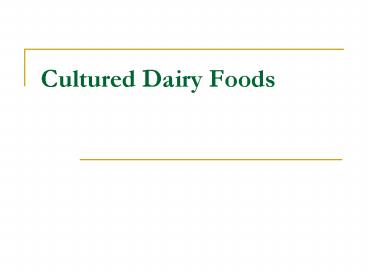Cultured Dairy Foods - PowerPoint PPT Presentation
1 / 14
Title: Cultured Dairy Foods
1
Cultured Dairy Foods
2
Cultured Dairy Products
- Bovine milk suitable for microbial fermentation
- contains 5 lactose, 3.3 protein, pH6.6-6.7,
aw1.0
3
Cultured Dairy Products
- Evolved on every continent
- Easy to produce, good shelf-lives, free of
harmful substances, pleasant sensory appeal - Yogurt like products
- Dahi (india), Jaban (Egypt, Lebanon), Jugar
(turkey) - Kefir and koumiss-made with lactose-fermenting
yeasts in addition to lactic acid bacteria - Contain alcohol
4
Consumption of Cultured Dairy Products
- Most popular cultured dairy products in the US
- Yogurt gt50 of all cultured dairy products
(mostly non-fat or low fat) - Sour cream (and sour cream-based dips)
increasing - Cultured buttermilk decreasing
- US consumption much less than EU
- Catch on new trends
5
Probiotics and Prebiotics
- Probiotics
- Live microbes which when administered in adequate
amounts confer a health benefit on the host (WHO) - Live and sufficient amount
- Health benefit beyond GI tract
- Suggested health benefits
- Reduce blood cholesterol
- Maintain intestinal health
- Alleviate intestinal bowel diseases
- Modulate immune system
- Reduce incidence of GI infections
- Reduce incidence of urinary and vaginal
infections - Alleviate lactose intolerance
- Anti-cancinogenic and anti-tumorogenic
- Reduce incidence and severity of diarrheal
diseases
6
Probiotics and Prebiotics
- Prebiotics
- Non-digestible food ingredients that beneficially
affects the host by selectively stimulating the
growth and/or activity of one or a limited number
of bacteria in the colon, and then improves host
health (Gilbson and Roberfroid, 1995) - Polysaccharides or oligosaccharides (Fig 1)
- FOS (fructooligosaccharides)
- GOS (galactooligosaccharides)
- Resemble the oligosaccharides found in human milk
- May promote the growth of bifidobacteria in
nursed infants
7
Common probiotics
- As culture adjunct intend to promote health,
instead of fermentation - Lactobacillus acidophilus-80 yogurt in the US
- Bifidobacterium
- Both in yogurt and other cultured and
non-cultured dairy products - Some strains also involved in fermentation
- Yakult-Japanese product made using a human GI
isolate of Lb. casei (strain Shirota) - Cultura-a European bioyogurt made with a human
isolate of Lb. casei F19 - Unfermented products as carriers of probiotics
- Sweet Acidophilus Milk
- Table 4.2
8
Fermentation Principles
- Milk and LAB culture (Table 4.3)
- Cultured versus directly set
- Functions
- Lactose
- Precipitate casein (pH4.6)
- Flavor compounds
- Syneresis
- Separation of water from the coagulated milk
- Considered unfavorable to reduce,
- Increase milk solids
- heat well above pateurization temp to denature
whey proteins - Incorporate stabilizers
- Using strains produce exopolysaccharide
- Ropy strain-EPS released or dis-attached
- EPS remains attached to the cells surface
9
Yogurt Cultures
- S. thermophilus and Lb. delbrueckii subsp.
bulgaricus - 11 ratio
- Synergistic growth
- S. thermophilus growth first, use free aa and
small peptides in milk, lower pH etc, preferred
environment for Lb. delbrueckii subsp. bulgaricus - Lb. delbrueckii subsp. bulgaricus proteolysis
helps S. thermophilus to grow - Lb. delbrueckii subsp. bulgaricus produce more
acid, S. thermophilus will decrease - So the cultures are grown separately, harvested
and mixed
10
Frozen Yogurt and Other Yogurt Products
- Frozen yogurt
- No federal standard of identify
- Some states have their own definitions
- Marketing purpose
- Minnesota definition
- Frozen dairy products made from a mix containing
safe and suitable ingredients including, but not
limited to, milk products. All or a part of the
milk products must be cultured with a
characterizing live bacterial culture that
contains the lactic acid producing bacteria
Lactobacillus bulgaricus and Streptococcus
thermophilus and may contain other lactic acid
producing bacteria. - Some stated require minimum acidity, ranging from
0.3 to 0.5
11
Cultured Buttermilk
- Buttermilk is the fluid remaining after cream is
churned into butter - Thin, watery liquid
- Rich in phospholipids
- Rarely consumed as a fluid drink, but good source
of natural emulsifiers - Typically spray dried and used as an ingredient
in processed food products - Cultured buttermilk
- Skim or low-fat milk fermented by suitable LAB
- Butter granules or flakes are occasionally added
to provide butter flavor and mouth feel
12
Cultured Buttermilk Manufacture
- Fig. 4-5
- Milk
- Heat
- Cool and inoculate mesophilic starter culture
- Cultures
- Acid producing flavor producing 51
- Acid producer homolactic L. lactis subsp. lactis
or cremoris - Flovor producer L. lactis diacetylactis,
Leuconostoc mesenteroides subsp. cremoris, or
Leuc. lactis (hetero) - Citrate fermentation
13
Sour Cream
- Same culture used for cultured buttermilk
- Use cream instead of milk
- Cream pasteurized but not extend as for
buttermilk or yogurt - Cream homogenized
- Starting material in the US 18-20 cream, or low
fat version (10) - Fig 4-7
14
Kefir
- One of the most popular cultured dairy products
in Middle East, Eastern Europe and Central Asia - Kefir grain added as insoluble particles
- Retrieved after fermentation by filtration
- LAB and yeast
- Contain as much as 2 ethanol
- US has to be lower or non-ethanol producers
- Fig 4-8, Table 1































